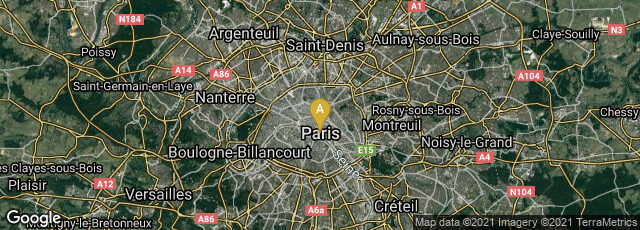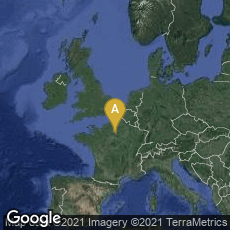

A: Paris, Île-de-France, France
In 1888 astronomer and prolific writer Camille Flammarion published L'atmosphère: météorologie populaire in Paris. What remains most notable about this work was a single wood engraved image which it published for the first time, known historically as the Flammarion engraving. This pastiche is one of the most widely studied and reproduced historical interpretations of man's quest for knowledge of the universe.
"The engraving depicts a man, clothed in a long robe and carrying a staff, who kneels down and passes his head, shoulders, and right arm through a gap between the starry sky and the earth, discovering a marvellous realm of circling clouds, fires and suns beyond the heavens. One of the elements of the cosmic machinery bears a strong resemblance to traditional pictorial representations of the "wheel in the middle of a wheel" described in the visions of the Hebrew prophet Ezekiel. One of the most significant features of the landscape is the tree, which some people have interpreted as the Kabbalistic Tree of Life. The caption that accompanies the engraving in Flammarion's book reads
"A missionary of the Middle Ages tells that he had found the point where the sky and the Earth touch..."
"In 1957, astronomer Ernst Zinner claimed that the image dated to the German Renaissance, but he was unable to find any version published earlier than 1906. Further investigation, however, revealed that the work was a composite of images characteristic of different historical periods, and that it had been made with a burin, a tool used for wood engraving only since the late 18th century. The image was traced to Flammarion's book by Arthur Beer, an astrophysicist and historian of German science at Cambridge and, independently, by Bruno Weber, the curator of rare books at the Zürich central library.
"Flammarion had been apprenticed at the age of twelve to an engraver in Paris and it is believed that many of the illustrations for his books were engraved from his own drawings, probably under his supervision. Therefore it is plausible that Flammarion himself created the image, though the evidence for this remains circumstantial. Like most other illustrations in Flammarion's books, the engraving carries no attribution. Although sometimes referred to as a forgery or a hoax, Flammarion does not characterize the engraving as a medieval or renaissance woodcut, and the mistaken interpretation of the engraving as an older work did not occur until after Flammarion's death. The decorative border surrounding the engraving is distinctly non-medieval and it was only by cropping it that the confusion about the historical origins of the image became possible. According to Bruno Weber and to astronomer Joseph Ashbrook, the depiction of a spherical heavenly vault separating the earth from an outer realm is similar to the first illustration in Sebastian Münster's Cosmographia of 1544, a book which Flammarion, an ardent bibliophile and book collector, might have owned.
"In Flammarion's L'atmosphère: météorologie populaire, the image refers to the text on the facing page (p. 163), which also clarifies the author's intent in using it as an illustration:
Whether the sky be clear or cloudy, it always seems to us to have the shape of an elliptic arch; far from having the form of a circular arch, it always seems flattened and depressed above our heads, and gradually to become farther removed toward the horizon. Our ancestors imagined that this blue vault was really what the eye would lead them to believe it to be; but, as Voltaire remarks, this is about as reasonable as if a silk-worm took his web for the limits of the universe. The Greek astronomers represented it as formed of a solid crystal substance; and so recently as Copernicus, a large number of astronomers thought it was as solid as plate-glass. The Latin poets placed the divinities of Olympus and the stately mythological court upon this vault, above the planets and the fixed stars. Previous to the knowledge that the earth was moving in space, and that space is everywhere, theologians had installed the Trinity in the empyrean, the glorified body of Jesus, that of the Virgin Mary, the angelic hierarchy, the saints, and all the heavenly host.... A naïve missionary of the Middle Ages even tells us that, in one of his voyages in search of the terrestrial paradise, he reached the horizon where the earth and the heavens met, and that he discovered a certain point where they were not joined together, and where, by stooping his shoulders, he passed under the roof of the heavens...
"The same paragraph had already appeared, without the accompanying engraving, in an earlier edition of the text published under the title of L'atmosphère: description des grands phénomènes de la Nature ("The Atmosphere: Description of the Great Phenomena of Nature," 1872). The correspondence between the text and the illustration is so close that one would appear to be based on the other. Had Flammarion known of the engraving in 1872, it seems unlikely that he would have left it out of that year's edition, which was already heavily illustrated. The more probable conclusion therefore is that Flammarion commissioned the engraving specifically to illustrate this particular text, though this has not been ascertained conclusively (Wikipedia article on Flammarion engraving, accessed 11-29-2012).